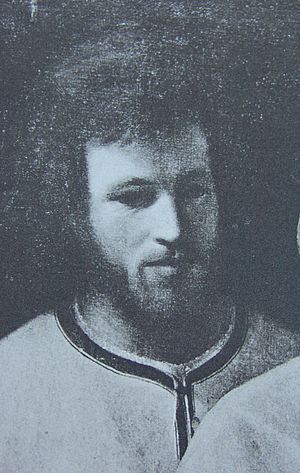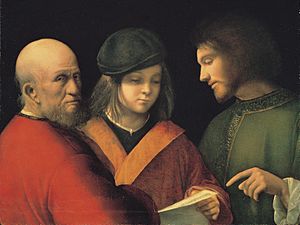Philippe Verdelot facts for kids
Philippe Verdelot (born between 1480 and 1485, died between 1530 and 1540) was a French composer from the Renaissance period. He spent most of his life in Italy. Many people consider him the "father" of the Italian madrigal, and he was certainly one of the first and most active composers of this type of music. He was also very important in the music scene of Florence after the powerful Medici family took back control of the city from the followers of Girolamo Savonarola.
Life
Verdelot was born in Les Loges, Seine-et-Marne, France. We don't know much about his early life. He probably moved to Italy when he was young. He likely spent his first years in the 1500s in cities in northern Italy, possibly including Venice. Some music experts believe a painting from 1511 shows Verdelot in Venice with an Italian singer.
We know that Verdelot was the maestro di cappella (which means music director) at the Baptisterium San Giovanni in Florence from 1523 to 1525. He also seemed to work at the Cathedral there from 1523 until 1527. In 1526, he worked with Niccolò Machiavelli on a performance of Machiavelli's famous play, La Mandragola. Even though the play was written in 1518, the 1526 show in Florence was dedicated to the Medici pope, Clement VII. Both Machiavelli and Verdelot usually supported the Florentine Republic against the Medici family. However, they tried to get along with both sides. The songs Verdelot wrote for Machiavelli's play, though called canzone, are thought to be some of the very first madrigals.
Besides supporting the Florentine Republic, Verdelot likely also supported the religious leader Girolamo Savonarola, who was killed for his beliefs. We can see this in some of Verdelot's music. For example, his song In te domine speravi is based on a psalm that Savonarola wrote about just before he died. Also, Verdelot used the tune most connected with Savonarola, Ecce quam bonum, in his motet Letamini in domino. This song was important for Savonarola's followers during his final struggles.
Verdelot might have died during the siege of Florence (1529–1530) or from a serious illness that affected the city at the same time. There is no clear proof that he was alive after 1530. It's thought he was in Florence during the siege because of one of his motets, Congregati sunt inimici nostri, which he wrote around that time. In this piece, he combined texts with a prayer for peace, "Da pacem Domine."
Some experts think Verdelot lived until about 1540. This is based on some hints in his works published in the 1530s that refer to events happening at that time. Several books of madrigals published in Venice in the late 1530s include his music. One of these books is even completely dedicated to him. He might have moved to Venice after the siege to escape the Medici family, who were known for being tough on their enemies. We know for sure he was dead by 1552, when a writer named Ortenzo Landi mentioned that he had passed away.
Music and Influence
Verdelot, along with Costanzo Festa, is seen as the founder of the madrigal. A madrigal is a type of song sung a cappella (without instruments). It appeared in the late 1520s, combining different older music styles like the frottola, the canzone, the laude, and even some influences from the more serious motet.
Verdelot's music often mixes parts where all voices sing the same rhythm (homophonic) with parts where voices copy each other (imitative). He rarely used "word-painting," which is when the music sounds like the words. This became more common later. Most of his madrigals are written for five or six voices.
Verdelot's madrigals were very popular. We know this because they were printed many times and spread widely across Europe in the 1500s. He also wrote motets and masses.
Works
Verdelot's complete works were published by The American Institute of Musicology.
Madrigals
- Benché ’l misero cor
- Con lagrime e sospir
- Divini occhi sereni
- Donna leggiadra et bella
- I vostr'acuti dardi
- Italia mia bench'il parlar
- Madonna il tuo bel viso
- Madonna per voi ardo
- Per altri monti
- Perche piu acerba
- Seule demeure et despourveue
Motets
- Beata es Virgo Maria
- Congregati sunt inimici nostri
- Si bona suscepimus
Masses
- Missa Philomna
- Missa La Gloria del Dixit Dominus
Hymns
- Hymno della Natività di Christo
- Hymno della Resurrectione di Christo
- Hymno dell'archangelo Rafaelo
- Hymno dei confessori
- Hymno del corpo di Christo
- Hymno di San Niccolo
- Hymno della Epiphania
- Hymno della Ascensione
- Hymno della Virgine
Magnificat
- Magnificat sexti toni
See also
 In Spanish: Philippe Verdelot para niños
In Spanish: Philippe Verdelot para niños



